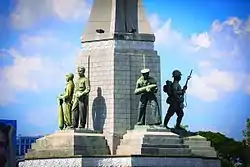Victory Monument (Bangkok)
Victory Monument (Thai: อนุสาวรีย์ชัยสมรภูมิ, RTGS: Anusawari Chai Samoraphum) is a military monument in Bangkok, Thailand. The monument was erected in June 1941 to commemorate the Thai victory in the Franco-Thai War. The monument is in Ratchathewi District, northeast of central Bangkok, at the center of a traffic circle in the intersection of Phahonyothin, Phaya Thai and Ratchawithi roads.
_%E0%B8%AD%E0%B8%99%E0%B8%B8%E0%B8%AA%E0%B8%B2%E0%B8%A7%E0%B8%A3%E0%B8%B5%E0%B8%A2%E0%B9%8C%E0%B8%8A%E0%B8%B1%E0%B8%A2%E0%B8%AA%E0%B8%A1%E0%B8%A3%E0%B8%A0%E0%B8%B9%E0%B8%A1%E0%B8%B4_%E0%B9%80%E0%B8%82%E0%B8%95%E0%B8%A3%E0%B8%B2%E0%B8%8A%E0%B9%80%E0%B8%97%E0%B8%A7%E0%B8%B5_%E0%B8%81%E0%B8%A3%E0%B8%B8%E0%B8%87%E0%B9%80%E0%B8%97%E0%B8%9E%E0%B8%A1%E0%B8%AB%E0%B8%B2%E0%B8%99%E0%B8%84%E0%B8%A3_(5).jpg.webp) The Victory Monument in 2022 | |
| Location | Ratchathewi District, Bangkok, Thailand |
|---|---|
| Nearest metro station | Victory Monument Station |
| Coordinates | 13°45′53″N 100°32′19″E |
| North | Phahonyothin Road |
| East | Ratchawithi Road |
| South | Phaya Thai Road |
| West | Ratchawithi Road |
| Construction | |
| Completion | 24 June 1942 |
| Other | |
| Designer | Pum Malakul |
Since its erection in 1941, the monument has become a regular spot for protests along with the Democracy Monument, with recent protests taking place in 2022 where protesters attended rallies against Prayut Chan-o-cha.[1]
Design

The monument is entirely Western in design. This is in contrast with another prominent monument of Bangkok, the Democracy Monument, which uses indigenous Thai forms and symbols. The central obelisk, although originally Egyptian, has been frequently used in Europe and the US for national and military memorials, its shape suggesting both a sword and masculine potency. Here it is executed in the shape of five bayonets clasped together. Five statues, representing the army, navy, air force, police, and civilian population, are depicted in Western "heroic" style, familiar in the 1940s in both fascist and communist states. They were created by the Italian sculptor Corrado Feroci, who worked under the Thai name Silpa Bhirasi. The sculptor did not like the combination of his work with the obelisk, and referred to the monument as "the victory of embarrassment".[2] On the obelisk is inscribed the names of 656 civilians and soldiers who lost their lives during the Franco-Thai War.[3]
History
In 1940–1941, Thailand fought a brief conflict against the Vichy French colonial authorities in French Indochina, this conflict was called the Franco-Thai War, which resulted in Thailand annexing some territories in western Cambodia and northern and southern Laos. These were among the territories which the Kingdom of Siam had ceded to France in 1893 and 1904, and nationalist Thais considered them to belong to Thailand.[2]
The fighting between the Thais and the French in December 1940 and January 1941 was brief and inconclusive. 54 Thai troops were killed, with the French sustaining 421 killed or wounded. In the final territorial settlement was imposed on both parties by Japan, which did not want to see a prolonged war between two regional allies at a time when it was preparing to launch a war of conquest in Southeast Asia. Thailand's gains were less than it had hoped for, although more than the French wished to concede. Nevertheless, the Thai regime of Field Marshal Plaek Phibunsongkhram celebrated the outcome of the war as a victory, and the monument was commissioned, designed, and erected within a few months.[2]
The monument became an embarrassment in a more political sense in 1945 when the Allies were victorious in the Pacific War they forced Thailand to evacuate the territories it had gained in 1941 and return them to France. Many Thais regard the monument as an inappropriate symbol of militarism and a relic of what they now see as a discredited regime. Nevertheless, the monument remains one of Bangkok's most familiar landmarks.[2]

Protests
During the 2020-2021 Thai Protests, protestors regularly battled with police around Bangkok including at the Victory Monument.[4] In October 2020, around 10,000 protestors gathered at the monument and blocked local traffic.[5] On August 7, 2021, a road near the monument was sealed off to prevent protestors from reaching the monument by police by using containers, although protestors had to be forced back with teargas.[6] On August 11, another protest this time organized by Thalufa (also known as Tha Lu Fa) ended with a battle between protestors trying to march on the Prime-minister's residence and police: with the police responding with rubber bullets and teargas, and protestors by setting a police truck on fire and also throwing fireworks which injured 8 officers.[7]
After the Thai Constitutional Court ruled that Prime-minister Prayut Chan-o-cha had not reached his term limit of 8 years in October 2022, the activist group Thalufah organized a protest at the Victory Monument with around 500 protesters attending.[1]
References
- "Hundreds in Bangkok Protest Court Ruling Allowing Thai PM to Stay in Office". VOA. 2022-10-01. Retrieved 2023-06-16.
- Based on the account in Ka F. Wong, Visions of a Nation: Public Monuments in Twentieth-Century Thailand, White Lotus, Bangkok 2006
- Administrator (2021-11-03). "The history of Victory Monument in Bangkok". Retrieved 2023-06-16.
- "Thai Protesters Face Off With Police in Bangkok". thediplomat.com. Retrieved 2023-06-16.
- Regan, Helen (2020-10-19). "Thailand's government vows to protect the monarchy after weekend of unrest". CNN. Retrieved 2023-06-16.
- "Thailand protesters clash with riot police over handling of Covid". The Guardian. 2021-08-07. ISSN 0261-3077. Retrieved 2023-06-16.
- "Police fire tear gas, rubber bullets at Victory Monument protest". Bangkok Post. Retrieved 2023-06-16.
External links
![]() Media related to Victory Monument, Bangkok at Wikimedia Commons
Media related to Victory Monument, Bangkok at Wikimedia Commons